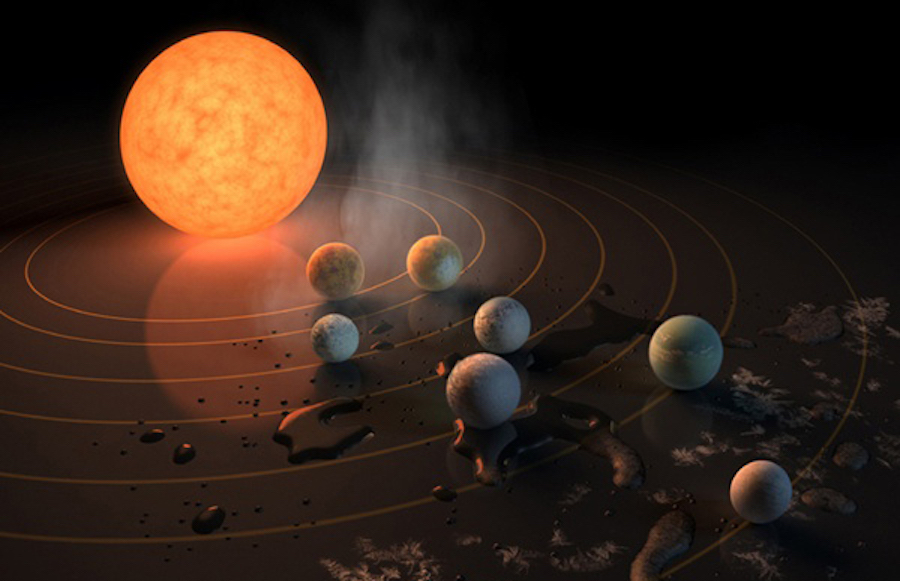Guest blog by Sharmila Kuthunur
 The TRAPPIST-1 system crams seven planets into less than the distance at which Mercury orbits the Sun. // NASA/JPL-Caltech
The TRAPPIST-1 system crams seven planets into less than the distance at which Mercury orbits the Sun. // NASA/JPL-Caltech
Back in 1999, when astronomers first discovered an ultra-cool red dwarf star safely tucked away in the constellation Aquarius (the Water-bearer), they simply catalogued it under the name 2MASS J23062928-0502285 and quickly forgot about it. Stars this small were not considered important to the hunt for extraterrestrial life.
It wasn’t until 2015, when a team of researchers led by Michaël Gillon at the University of Liege in Belgium detected seven Earth-like planets orbiting this star — better known as TRAPPIST-1 — that the world began to acknowledge the importance of the discovery. All seven of TRAPPIST-1’s planets had the right conditions to support life. It was the first time that so many Earth-like planets were discovered orbiting such a totally unexpected type of star.
Ultra-cool red dwarfs are ten times smaller and twice as cool as Sun-like stars. Since a red dwarf’s fluctuating magnetic activity can erode its planets’ atmospheres, and because red dwarf planets are tidally locked, receiving little light for photosynthesis, habitability around them was simply unheard of.
This artist’s concept shows the size of TRAPPIST-1, an ultra-cool red dwarf, as compared to the Sun. TRAPPIST-1 has a radius about 10 times smaller than that of the Sun, and is nearly twice as cool. // ESO
“This is the first and only system to have seven Earth-sized planets, where three are in the habitable zone of the star,” said Hannah Wakeford, postdoctoral fellow at NASA. “It is also the first system bright enough, and small enough, to make it possible for us to look at each of these planets’ atmospheres. The more we can learn about exoplanets, the more we can understand how our own solar system came to be the way it is.”
The discovery of TRAPPIST-1 put the world into a frenzy because ultra-cool dwarfs were not considered a likely place for life to emerge and thrive. However, due to their small size, a much higher amount of their light is blocked when a cool dwarf’s planet transits in front of it, making planetary detections more noticeable. Being cooler than solar-type stars, which when combined with their small size, also results in favorable contrasts in flux between an Earth-like planet and its ultra-cool-dwarf host, making measurements of planets’ emission spectrums much easier.
Yet, all of the previous exploration missions have focused on searching for life in Sun-like star systems.
This artist’s concept depicts the orbital distances of each of Trappist-1’s seven planets. // Astronomy/Roen Kelly
Sun-like stars only make up 15% of the stellar population in the entire universe. Since binary star systems dominate more than half of that 15%, we are left with a severely limited sample of truly Sun-like stars. So why, when we have the entire universe to explore, do we focus on a tiny segment of it? Detecting life elsewhere in the universe in systems like our own would undoubtedly be a great scientific success, but there would be very little, if anything, that we could actually learn about the overall evolution of life.
If life is detected in any one of the seven rocky planets around TRAPPIST-1, it would mean life is a frequent occurrence and not a mere cosmic accident. Since astronomers have identified nearly a thousand other potentially habitable, ultra-cool-dwarf systems with current technology, if life is detected in the TRAPPIST-1 system, it has every right to exist in any or all of the other thousand systems.
The presence of life beyond our solar system would mean that life emerges easily when the basic conditions are met (simple organic molecules, liquid water, radiation from a star and/or energy released from a planet). This would make life a nearly universal phenomenon.
However, if astronomers never detect any signs of life on any of the planets around cool-dwarf stars, we would have to face the disappointing realization that life is extremely rare. We can then focus on discovering habitable planets in sun-like star systems without further ado.
Irrespective of the outcome, what matters the most is the fact that we now have the opportunity to go from speculation to observation. The James Webb Space Telescope aims to use spectroscopy, a method where light is split into distinct wavelengths to identify its chemical components, to understand the atmospheric elements of TRAPPIST-1’s planets. A detailed characterization that includes detection of biosignatures (methane and ozone that are formed due to biological processes) is also a part of the James Webb mission.
“But some of these molecules could be formed abiotically, without life. The firm detection of life will require [us] to detect several molecules in relative proportions that could only be explained by life”, said Gillion, initiator and lead author of the TRAPPIST-1 discovery.
In addition to the James Webb Telescope, future astronomical facilities like the European Extremely Large Telescopes and the NASA mission concept OST or LUVOIR, optimized for infrared wavelengths, could detect biosignatures on TRAPPIST-1 planets as well.
Moreover, learning to broaden the range of our telescopes is by itself a great success in the hunt for alien life. From our efforts to look for life elsewhere, we can only learn more about life and its presence in the universe.
We are either a small portion of a much larger evolution, or we are the rare species that has been given the precious chance to exist, albeit in isolation. I don’t know about you, but to me, both of these possibilities are equally fascinating.